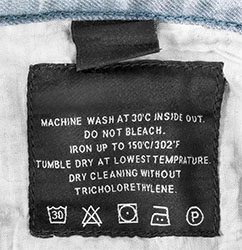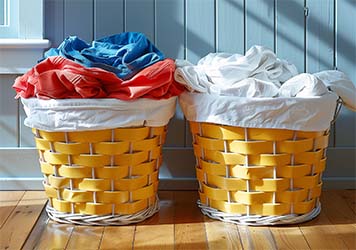In today’s fast-paced world, where fashion trends come and go, it’s more important than ever to make our clothes last longer. Not only does this save money, but it also helps reduce our environmental footprint. By adopting simple yet effective habits, we can extend the life of our clothing. Especially those favorite t-shirts, since everyone has them. Here are 16 tips to ensure your clothes stay in great condition for years to come.
1. Understand the Care Labels

Ever wonder what those tiny symbols on your clothing tags mean? They’re not just there for decoration. These laundry symbols provide crucial information on how to properly care for each garment. Understanding and following these instructions can prevent damage and extend the life of your clothes. For instance, a triangle means you can bleach, while a circle with a cross through it means you should avoid dry cleaning.
2. Proper Sorting Techniques
Sorting your laundry correctly can make a significant difference in how long your clothes last. Separate your laundry by color, fabric type, and washing temperature. Whites should be washed separately from colors, and delicate fabrics should be kept apart from heavier items. This prevents color bleeding and reduces wear and tear on delicate items.

3. Immediate Stain Treatment
Stains are inevitable, but letting them set can make them permanent. Treat stains as soon as they occur using natural solutions like vinegar and baking soda. Apply vinegar to the stain, rub it with a paste made from equal parts vinegar and baking soda, then rinse with cold water before washing.
4. Wash Less Frequently
Not all clothes need to be washed after every wear. Overwashing can cause the fabric to wear out faster. For instance, t-shirts can often be worn a couple of times before needing a wash, while jeans, sweatshirts, and hoodies can go even longer. This not only preserves the fabric but also saves water and energy.
5. Avoid Overloading the Washing Machine
Cramming too many clothes into the washing machine can lead to poor cleaning and increased friction between garments, causing damage. Ensure your machine is filled but not overloaded, allowing clothes to move freely for a thorough clean.
6. Select the Right Washing Program
Using the correct washing program for different fabrics is essential. Gentle cycles and appropriate water temperatures can prevent damage. For example, delicate fabrics benefit from cold water and a gentle wash cycle, while sturdier fabrics can handle warmer water and a regular cycle.
7. Use the Correct Amount of Detergent

Using too much detergent can leave residue on your clothes, making them stiff and less vibrant. Always follow the detergent instructions and consider using less than the recommended amount. Modern detergents are highly concentrated, so a little goes a long way.
8. Mastering the Ironing Process
Proper ironing can keep your clothes looking sharp without damaging them. Always check the care label for the appropriate ironing temperature. Start with the collar, move to the cuffs, and then iron the rest of the garment. Using steam can also help remove wrinkles without scorching the fabric.
9. Proper Storage Techniques
Storing clothes correctly is crucial for maintaining their shape and longevity. Keep your clothes in a cool, dry place, and use wooden or padded hangers to prevent stretching. Heavy items like sweatshirts should be folded rather than hung to avoid stretching the fabric.
10. Air Drying vs. Machine Drying

Air drying is gentler on clothes than machine drying, reducing the risk of shrinkage and fading. If you must use a dryer, consider using a low heat setting and remove clothes while they are still slightly damp to finish air drying.
Although it’s not necessary, we highly recommend air drying your clothing and shirts from Wohtees to keep the colors and prints as vibrant as possible well into the future.
11. Using Delicates Bags
Wash delicate items like tank tops and hoodies in mesh bags to protect them from snagging and stretching. Delicate bags also help reduce friction between clothes, keeping them in better condition.
12. Cold Washing for Dark Clothes and Denim
Wash dark clothes and denim inside out in cold water to preserve their color and shape. Cold water prevents dyes from running and helps maintain the fabric’s integrity, keeping your clothes looking new longer.
13. Avoid Dry Cleaning
Traditional dry cleaning uses harsh chemicals that can damage fabrics over time. Instead, look for eco-friendly cleaning services that use gentler methods, or try hand washing delicate items at home.
14. Keep Your Closet Tidy
An organized closet prevents clothes from getting crushed and wrinkled. Check your closet to ensure everything has space and remove items you no longer wear. This not only keeps your clothes in better shape but also makes it easier to find what you need.
15. Eco-Friendly Fabric Choices
Choosing eco-friendly fabrics can also contribute to the longevity of your clothes. Natural fibers like organic cotton, linen, and bamboo are not only sustainable but also durable. These fabrics are often less processed and contain fewer chemicals, which means they’re gentler on your skin and the environment.
16. Regular Maintenance with Lint Rollers and Fabric Shavers

Keep your clothes looking fresh by using a lint roller to remove dust and hair, and a fabric shaver to get rid of pilling. Regular maintenance helps your garments look new and prolongs their lifespan.
Conclusion
By following these tips, you can make your clothes last longer, save money, and reduce your environmental impact. Implement these practices into your routine to keep your clothes looking their best. Remember, taking care of your clothes not only benefits you but also contributes to a more sustainable future. Happy laundering!





